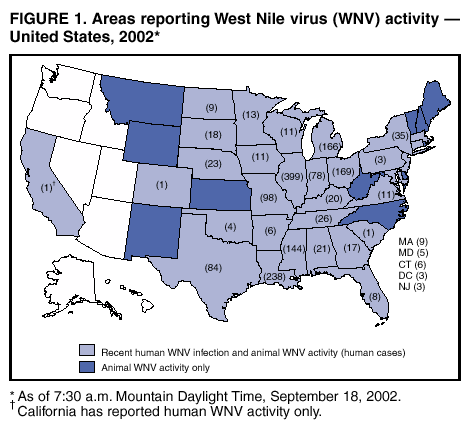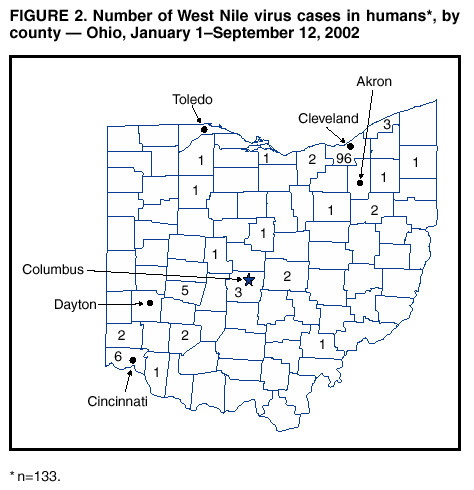 |
|
|
|
|
|
|
| ||||||||||
|
|
|
|
|
|
|
||||
| ||||||||||
|
|
|
|
|
Persons using assistive technology might not be able to fully access information in this file. For assistance, please send e-mail to: mmwrq@cdc.gov. Type 508 Accommodation and the title of the report in the subject line of e-mail. West Nile Virus Activity --- United States, September 12--18, 2002, and Ohio, January 1--September 12, 2002This report summarizes West Nile virus (WNV) surveillance data reported to CDC through ArboNET and by states and other jurisdictions as of 7:30 a.m. Mountain Daylight Time, September 18, 2002. United StatesDuring the reporting period of September 12--18, a total of 440 laboratory-positive human cases of WNV-associated illness were reported from Illinois (n=107), Ohio (n=76), Michigan (n=50), Indiana (n=36), Missouri (n=23), Mississippi (n=22), Texas (n=17), Louisiana (n=16), New York (n=13), Georgia (n=11), Iowa (n=10), Kentucky (n=eight), Nebraska (n=eight), Alabama (n=seven), Virginia (n=six), Minnesota (n=five), North Dakota (n=five), South Dakota (n=five), Connecticut (n=three), Tennessee (n=three), Florida (n=two), Massachusetts (n=two), Pennsylvania (n=two), Colorado (n=one), New Jersey (n=one), and Oklahoma (n=one). During this period, Colorado reported its first human WNV case ever. During the same period, WNV infections were reported in 525 dead crows, 509 other dead birds, 552 horses, and 399 mosquito pools. During 2002, a total of 1,641 human cases with laboratory evidence of recent WNV infection have been reported from Illinois (n=399), Louisiana (n=238), Ohio (n=169), Michigan (n=166), Mississippi (n=144), Missouri (n=98), Texas (n=84), Indiana (n=78), New York (n=35), Tennessee (n=26), Nebraska (n=23), Alabama (n=21), Kentucky (n=20), South Dakota (n=18), Georgia (n=17), Minnesota (n=13), Iowa (n=11), Virginia (n=11), Wisconsin (n=11), Massachusetts (n=nine), North Dakota (n=nine), Florida (n=eight), Arkansas (n=six), Connecticut (n=six), Maryland (n=five), Oklahoma (n=four), the District of Columbia (n=three), New Jersey (n=three), Pennsylvania (n=three), California (n=one), Colorado (n=one), and South Carolina (n=one) (Figure 1). Among the 1,371 patients with available data, the median age was 55 years (range: 3 months--99 years); 731 (53%) were male, and the dates of illness onset ranged from June 10 to September 11. A total of 72 human deaths have been reported. The median age of decedents was 79 years (range: 42--99 years); 42 (58%) deaths were among men. In addition, 4,562 dead crows and 3,366 other dead birds with WNV infection were reported from 42 states, New York City, and the District of Columbia; 2,244 WNV infections in mammals (all equines) have been reported from 31 states (Alabama, Arkansas, Colorado, Florida, Georgia, Illinois, Indiana, Iowa, Kansas, Kentucky, Louisiana, Maryland, Minnesota, Mississippi, Missouri, Montana, Nebraska, New Jersey, New Mexico, New York, North Dakota, Ohio, Oklahoma, Pennsylvania, South Carolina, South Dakota, Tennessee, Texas, Vermont, Virginia, and Wyoming). During 2002, WNV seroconversions have been reported in 191 sentinel chicken flocks from Florida, Iowa, Nebraska, Pennsylvania, and New York City; 2,976 WNV-positive mosquito pools have been reported from 25 states (Alabama, Arkansas, Connecticut, Delaware, Georgia, Illinois, Indiana, Iowa, Kentucky, Maryland, Massachusetts, Mississippi, Missouri, Nebraska, New Hampshire, New Jersey, New York, North Carolina, Ohio, Pennsylvania, Rhode Island, South Dakota, Texas, Vermont, and Virginia), New York City, and the District of Columbia. OhioDuring January 1--September 12, 2002, the Ohio Department of Health (ODH) identified 133 persons with positive initial test results for WNV in cerebrospinal fluid or serum (IgM ELISA); three cases were laboratory confirmed at CDC by plaque reduction neutralization test. Seven cases were fatal. The 133 patients had a median age of 61 years (range: 9--98 years); 71 (53%) were male. The median age for 29 patients with known diagnosis of either aseptic meningitis (17 cases), encephalitis (10 cases), meningo-encephalitis (one case) or acute flaccid paralysis (one case) was 52 years (range: 9--86 years); 14 (48%) were male. The median age of the seven decedents was 79 (range: 68--88 years) years; five (71%) were men. Onset of symptoms of WNV infection among reported patients occurred during July 27--September 8. All cases remain under investigation. Human cases have occurred among residents of 20 counties (Figure 2), with 96 (72%) cases reported from the most populated county in Ohio, Cuyahoga County, which includes Cleveland with 32 cases. The attack rate during January 1--September 12 was 1.2 per 100,000 for the state population, 7.0 for Cuyahoga County, and 6.7 for Cleveland. Of Ohio's 88 counties, 87 (99%) reported WNV activity in horses, birds, or mosquitoes. The first bird tested positive on May 19. Of the 1,643 dead birds tested, 855 (52%) have tested positive for WNV by polymerase chain reaction. Mosquito pools began testing positive on May 28. Through September 11, a total of 1,018 mosquito pools have tested positive, and 133 horses from 49 counties have tested laboratory positive. Public health authorities plan to continue surveillance for human and equine cases through October. The Ohio WNV Work Group comprises representatives from the departments of Health, Agriculture, Environmental Protection, and Natural Resources and coordinates surveillance and response activities. Ohio has a program for technical support of public agencies performing mosquito-management services. The established partnership between the Ohio Mosquito Control Association, ODH, the Ohio Pest Control Association, the Ohio State University Extension, and local mosquito-control agencies provided training to persons with an interest in mosquito management. ODH helps local governments establish mosquito-management programs. Ohio's prevention activities include risk communication and informing the public about how to avoid exposure through source reduction and personal protection. Pamphlets, fact sheets, and posters have been disseminated through local health departments. ODH also established the WNV Telephone Information Line to handle questions from the public. During August 1--September 12, a total of 3,884 phone calls were received. Additional information about WNV activity in Ohio is available at http://www.odh.state.oh.us. Additional information about WNV activity is available from CDC at http://www.cdc.gov/ncidod/dvbid/westnile/index.htm and http://www.cindi.usgs.gov/hazard/event/west_nile/west_nile.html. Figure 1  Return to top. Figure 2  Return to top.
Disclaimer All MMWR HTML versions of articles are electronic conversions from ASCII text into HTML. This conversion may have resulted in character translation or format errors in the HTML version. Users should not rely on this HTML document, but are referred to the electronic PDF version and/or the original MMWR paper copy for the official text, figures, and tables. An original paper copy of this issue can be obtained from the Superintendent of Documents, U.S. Government Printing Office (GPO), Washington, DC 20402-9371; telephone: (202) 512-1800. Contact GPO for current prices. **Questions or messages regarding errors in formatting should be addressed to mmwrq@cdc.gov.Page converted: 9/19/2002 |
|||||||||
This page last reviewed 9/19/2002
|